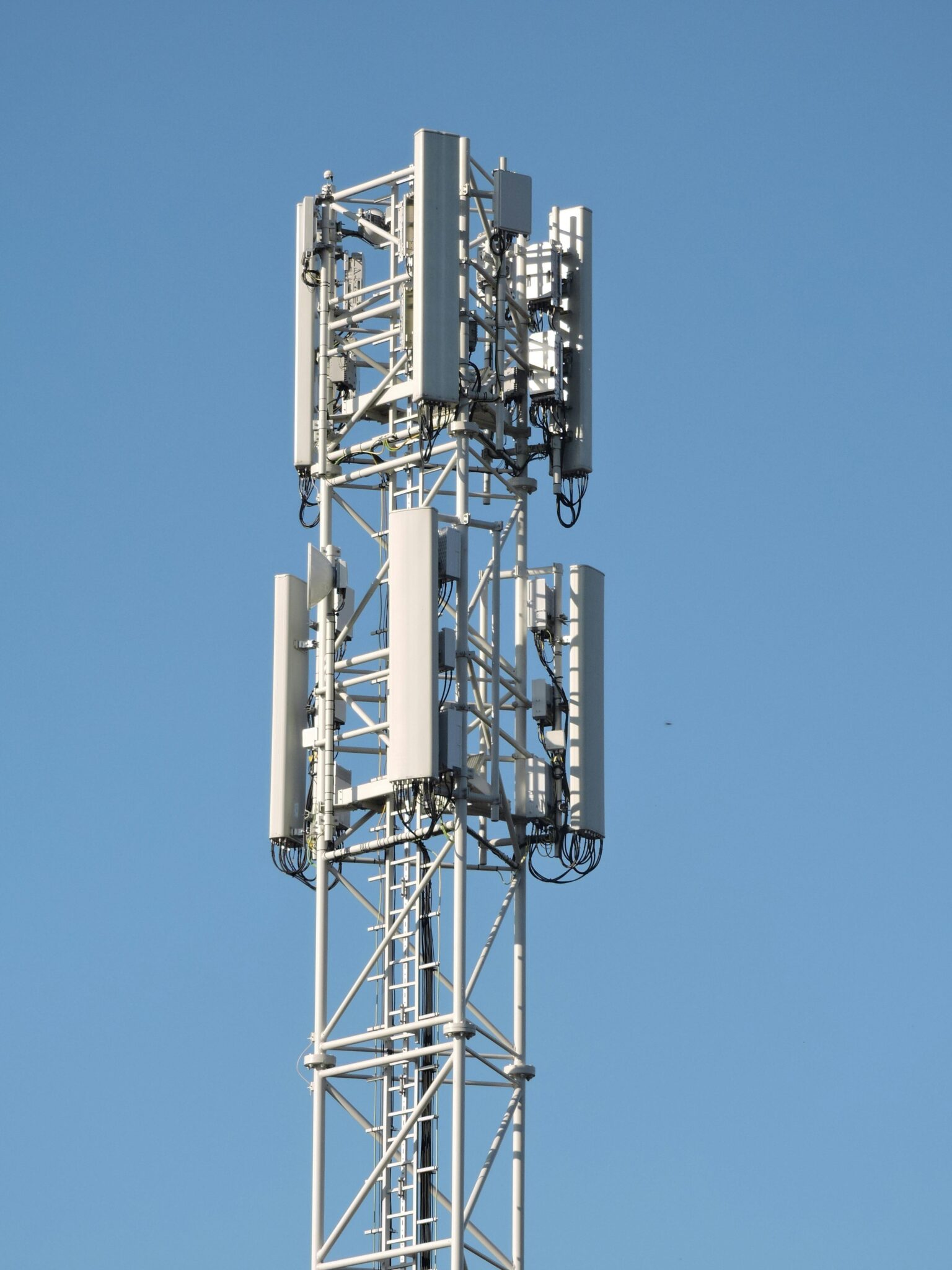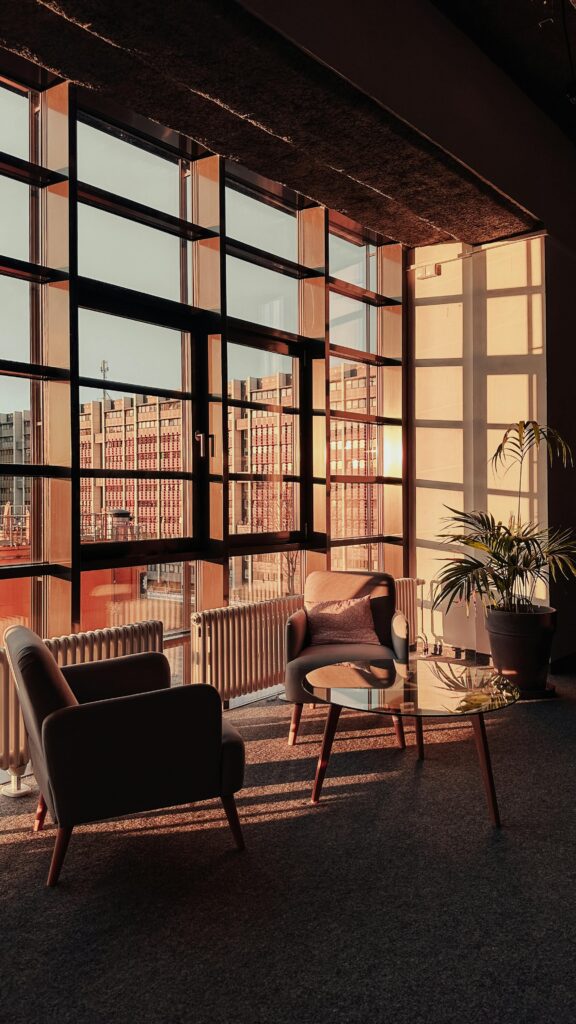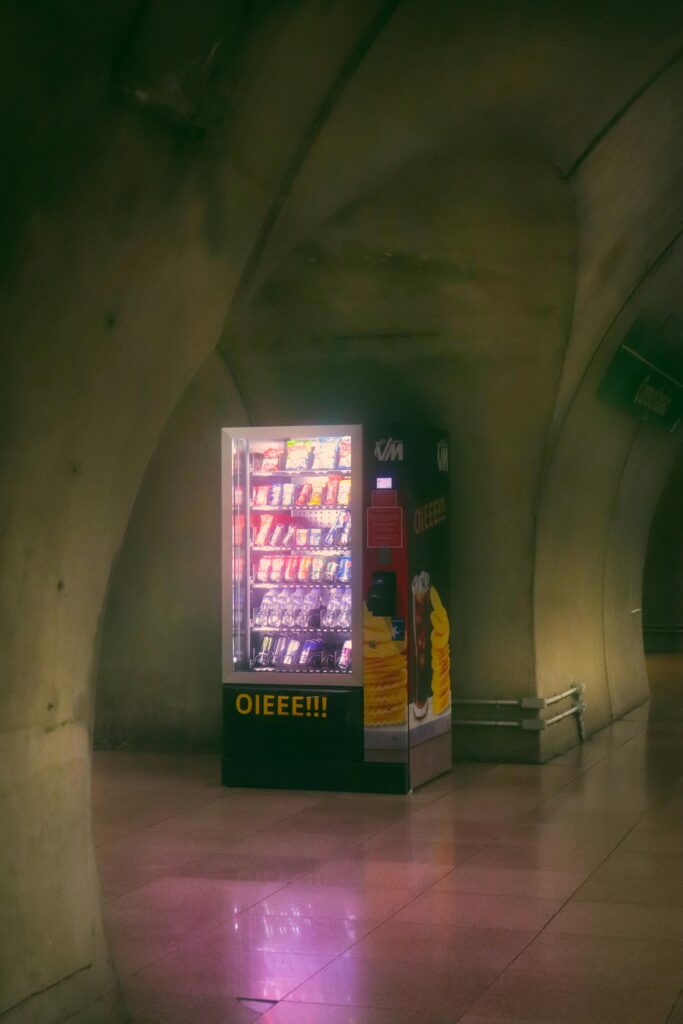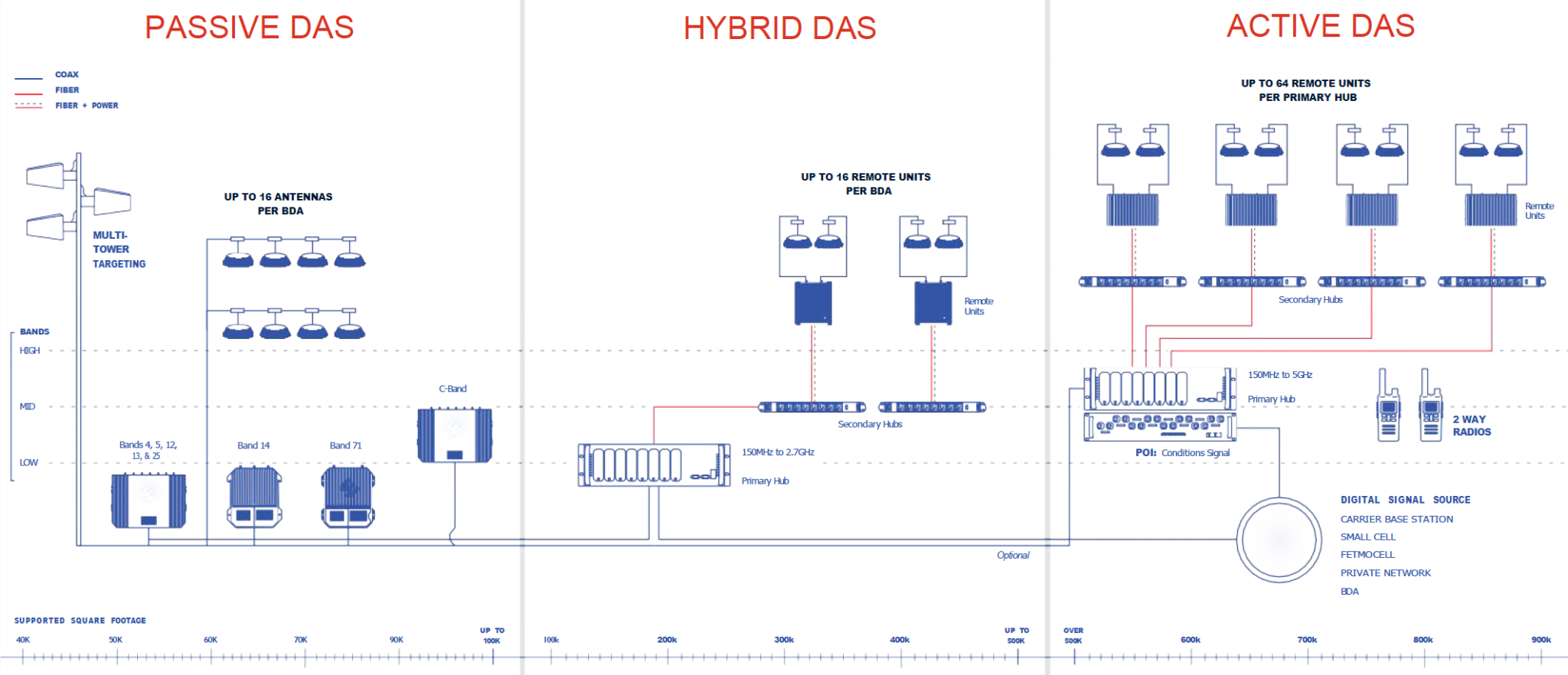Distributed Antenna Systems (DAS)
Enhancing Indoor Connectivity

What is DAS?
A Distributed Antenna System (DAS) is a network of strategically placed antennas that enhance cellular coverage and capacity within buildings and large facilities. By distributing signals across multiple access points, DAS ensures strong, consistent connectivity where traditional cell towers struggle to penetrate, such as high-rise buildings, hospitals, stadiums, and office complexes.
Why DAS Matters for Your Business
Enterprise mobility has evolved from a luxury to a necessity. With 80% of cellular usage happening indoors, businesses can no longer afford weak signals or dead zones. DAS solutions provide seamless 4G LTE and 5G coverage, ensuring employees, customers, and visitors stay connected at all times.

Key Benefits of DAS Solutions:
✔ Reliable Indoor Coverage
Eliminates dead zones and ensures uninterrupted voice and data communication.
✔ Future-Ready for 5G
DAS solutions integrate with modern 5G technology, ensuring high-speed data and low latency.
✔ Wi-Fi-Like Economics
DAS operates efficiently, providing a cost-effective solution for large-scale connectivity.
✔ Supports High-Density Environments
Ideal for offices, hospitals, retail spaces, and venues where multiple users demand strong signals simultaneously.
✔ Improved Business Efficiency
Supports critical applications such as cloud computing, IoT, and remote collaboration without network interruptions.
✔ Enhanced Public Safety Communication
Ensures first responders have uninterrupted radio and cellular communication in emergencies, meeting building code requirements for in-building wireless coverage.

How DAS Works
A DAS system consists of a horizontal fiber backbone that distributes cellular signals to multiple indoor antennas. These antennas amplify the signal within the building, ensuring “inside-the-building” signal delivery with a dense array of radios on each floor. This setup is critical for businesses where strong, uninterrupted connectivity is required for operations, customer engagement, and safety.
Is DAS Right for Your Business?
Enterprise executives expect reliable and seamless connectivity on their smartphones. A robust indoor cellular solution ensures consistent high-speed coverage, enabling uninterrupted communication and productivity throughout the building.
Contact us today to learn how Infinity Networks can design and implement a DAS solution tailored to your needs.


Passive DAS Solutions
A Passive Distributed Antenna System (DAS) enhances indoor cellular coverage by leveraging a network of antennas that capture and amplify signals from nearby cell towers. This cost-effective solution is ideal for buildings up to 75,000 sq. ft., ensuring strong and consistent connectivity for all major carriers and frequency bands.
By implementing a Passive DAS solution, businesses can ensure reliable mobile connectivity, increase productivity, and enhance user experience within their facilities.
Seamless Wireless Optimization:
- Utilizes FCC pre-approved components for quick and hassle-free installation.
- Nunc ut quam
Precise Signal Enhancement:
- Advanced technology enables fine-tuning of signal strength using wideband or channelized modes.
Reliable and Secure Technology:
- Engineered with high-quality components to minimize security concerns and maximize performance.
Multi-Tower Targeting:
-
Captures signals from multiple towers
to enhance reliability and network redundancy. - Nunc ut quam
Scalable and Cost-Effective:
- Provides a flexible solution for businesses needing improved cellular coverage without extensive infrastructure changes.

Hybrid DAS Solutions
A Hybrid Distributed Antenna System (DAS) blends the best of both passive and active DAS technologies to deliver high-performance wireless coverage with increased flexibility. By leveraging RF over fiber, Hybrid DAS enables fast installation, optimized signal distribution, and seamless scalability for buildings up to 500,000 sq. ft.
Hybrid DAS provides the power and agility needed to meet modern connectivity demands, making it an ideal solution for large facilities, enterprises, and mission-critical environments.
Rapid Wireless Optimization:
- Uses pre-configured core components for quick deployment and enhanced coverage.
Multi-Carrier, Multi-Band Flexibility:
- Supports CBRS, First Responder bands, C-Band, and more—without replacing the entire network.
Enhanced Signal Quality:
- Combines BDA amplification with fiber-optic technology for low latency, high bandwidth, and minimal signal loss.
Scalability for Future Growth:
- Easily expands coverage with additional bands and fiber components as connectivity needs evolve.
Advanced Modularity:
- Offers wideband and channelized optimization, ensuring seamless connectivity for a variety of applications.

Active DAS Solutions
Active Distributed Antenna System (DAS) is a powerful and scalable solution designed to deliver high-performance wireless connectivity in large venues, high-rise buildings, and mission-critical environments. By using radio frequency (RF) over fiber, Active DAS ensures seamless signal distribution, greater capacity, and superior coverage—even in the most challenging locations. With the ability to support buildings and facilities up to 1 million square feet, Active DAS is ideal for large-scale deployments.
Optimized Wireless Performance:
- Active DAS directly connects to the network, amplifying and distributing signals for maximum coverage, capacity, and quality.
Future-Ready Scalability:
- Designed with open architecture and modular technology, making it easy to add new frequency bands and upgrade technologies without major infrastructure changes.
Ultra-Wideband Support:
- Delivers reliable multi-band, multi-carrier coverage with a streamlined system using just a few key components.
Secure & Reliable Connectivity:
- A direct wired connection to the signal source minimizes interference, enhances security, and ensures consistent performance at scale.
Expansive Coverage :
- Supports buildings up to 1 million square feet, making it the ideal solution for large enterprises, stadiums, airports, hospitals, and other high-density environments needing robust, uninterrupted wireless connectivity.

Cellular Repeater Solutions
Cellular repeaters are designed to enhance signal coverage and ensure reliable, uninterrupted connectivity for IoT and M2M devices. The IoT 5-Band cellular repeater offers a powerful, compact solution to amplify cellular signals, making it ideal for use in custom IoT communication systems, especially in areas with limited or weak network coverage. Whether it’s for ATMs, kiosks, or self-service terminals, cellular repeaters ensure these devices remain online and fully operational.
Cellular repeaters offer the robust and scalable solution needed to enhance IoT device performance, making them a valuable addition for businesses looking to optimize connectivity and ensure reliable service.
Reliable Connectivity for IoT Devices:
- Keeps essential IoT systems like ATMs, vending machines, and self-service kiosks online, ensuring smooth and continuous operation without data interruptions.
Extend 5G Coverage:
- Amplifies low-band 5G signals for IoT devices, ensuring faster speeds and reliable performance in areas where 5G coverage may otherwise be weak or inconsistent.
Scalable Solution:
- Easily integrates with existing WilsonPro systems or operates as a standalone solution, providing flexibility to grow with your network and accommodate expanding IoT needs.
Quick Installation and Immediate ROI:
- The cost-effective repeater can be installed in days with minimal disruption, providing immediate improvements in connectivity and a rapid return on investment.
Enhanced Coverage for Critical Applications:
- Ideal for boosting cellular signals in high-demand environments like ATMs, kiosks, vehicles, and security systems, ensuring IoT devices maintain stable communication even in challenging locations.

Frequently Asked Questions
A Distributed Antenna System (DAS) is a network of antennas connected to a common signal source designed to optimize cellular signals within a building. DAS enhances wireless coverage by distributing signals in areas with weak cellular connectivity, ensuring reliable in-building connectivity for all users.
The main difference between passive, active, and hybrid DAS systems lies in how they collect and distribute cell signals:
- Passive DAS: The system collects signals from outside and distributes them through coaxial cables.
- Active DAS: Signals are generated via a direct connection to a signal source (such as a base station or small cell) and distributed through fiber optics, providing more extensive coverage and superior signal quality.
- Hybrid DAS: Combines elements of both passive and active systems by using fiber optics while collecting signals from outside sources, optimizing coverage and signal strength.
Yes, an Active DAS solution is perfect for large outdoor venues such as stadiums. It supports large areas with high user density, ensuring seamless connectivity during high-traffic events. The system leverages fiber optics to manage large volumes of voice and data traffic and supports multiple carriers and frequencies across the venue.
Active DAS is ideal for large facilities (over 500,000 sq. ft.) with high device density, such as stadiums, convention centers, airports, malls, hospitals, and office buildings. It offers extended coverage, lower signal attenuation over distance, and higher quality signal transmission due to its fiber-optic design.
Organizations justify the cost of an Active DAS by considering the significant improvements in customer experience, which translate into increased revenue, better reputation, and higher customer retention. Active DAS also provides scalability, lower maintenance costs, and enhanced public safety communication, which is essential for compliance with safety regulations.
Cellular DAS is beneficial in facilities with poor signal coverage, resulting in dropped calls or slow data. Ideal buildings include:
- Stadiums and arenas
- Healthcare complexes
- Educational institutions
- Malls and retail centers
- Manufacturing facilities
- Hotels and convention centers
- High-rise commercial buildings
Modern building materials like concrete, stone, metal, and insulated glass can block cellular signals, resulting in weak connectivity for smart devices. These materials, often used in energy-efficient buildings, make it difficult for signals to penetrate and reach IoT devices.
A cellular repeater amplifies weak signals, improving connectivity and data transmission for IoT/M2M devices. By boosting the existing cellular signal, repeaters help prevent dropped connections, reduce latency, and improve overall device performance.
